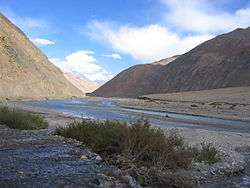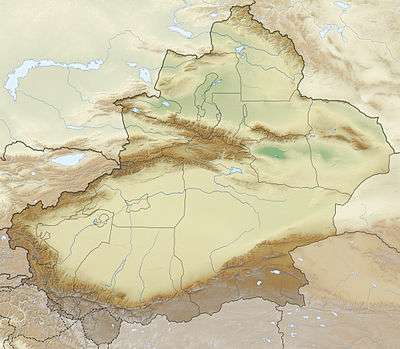Karakash River
| Karakash River | |
|---|---|
 Karakash River in western Kunlun Mountains | |
| Country | India (disputed), China |
| Provinces | Aksai Chin, Xinjiang |
| Physical characteristics | |
| Main source |
Karakoram range Aksai Chin 19,000 feet (5,800 m) 34°54′26″N 78°28′22″E / 34.907349°N 78.472665°E |
| River mouth |
Tarim River 40°28′23″N 80°56′08″E / 40.472964°N 80.935417°E |
| Length | 740 km (460 mi) |
| Discharge |
|
| Basin features | |
| Progression | Khotan River |
| Basin size | 19,983 km2 (7,715 sq mi) |
| Landmarks | Xaidulla, Khotan |
The Karakash or Black Jade River, also spelled Karakax (Chinese: 喀拉喀什河; pinyin: Kālākāshí Hé, Uyghur: قاراقاش دەرياسى, ULY: Qaraqash Deryasi ), is a river in the Xinjiang autonomous region of the People's Republic of China that originates in the disputed Aksai Chin region. The river begins above 19,000 feet (5,800 m) about 7 miles (11 km) northeast of Galwan Kangri peak in the Aksai Chin region. It flows north to Sumnal (15,540 ft), then turns sharply eastwards (skirting just north of the Soda Plains of Aksai Chin) until just beyond Palong Karpo, when it turns sharply northwestwards, and crosses into Xinjiang proper. It flows past the towns of Sumgal, Fotash, Gulbashem, until it reaches Xaidulla.
The river then turns sharply northeastwards again near Xaidulla, and, after passing through Ali Nazar crosses the Kunlun mountain range near the Suget or Sanju Pass, passing east of Khotan, running parallel to the Yurungkash River, which it joins near Koxlax (some 200 km north of Khotan, 38°05′N 80°34′E / 38.08°N 80.56°E), from where it continues north as the Khotan River passing Piqanlik (40°03′N 80°53′E / 40.05°N 80.89°E), and seasonally crossing the desert, joining the Tarim River at 42°29′N 80°56′E / 42.483°N 80.933°E.
The Karakash River is famous for its white and greenish jade (nephrite) carried as river boulders and pebbles toward Khotan, as does the nearby Yurungkash (or 'White Jade') River. This river jade originates from eroded mountain deposits of which the most famous one is near Gulbashen, in southwestern Xinjiang (formerly Chinese Turkestan).
The Karakash Valley was also a caravan road for the north-south trade between Yarkand (China) and Leh over the Karakoram Pass in Leh District of Jammu and Kashmir.
